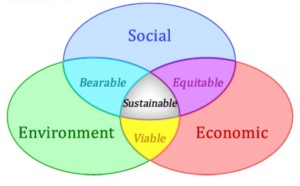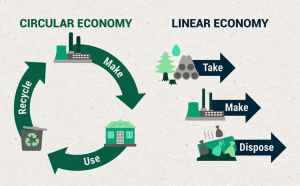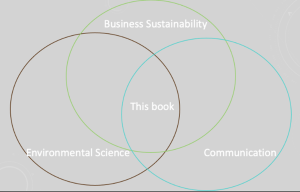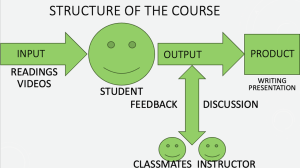Chapter 1a: Introduction to Communicating Planetary Sustainability in Business Communication
“Industry and the environment do not have to be at odds, and if we work to find the right solutions, the two can (and must) work together.”
-Lyft co-founders’ carbon neutral announcement
Objectives
After reading this chapter, students should be able to:
- Define sustainability in its modern context
- Comprehend the Brundtland Commission’s definition of sustainability and its significance in framing global conversations about sustainable development
- Explain the importance of incorporating sustainability education across disciplines,
- Emphasize the need for climate literacy, critical thinking, and problem-solving skills for university students
- Recognize the importance of effective communication in sustainability practices
An Introduction to Sustainability
In 1987, the United Nations Brundtland Commission defined sustainability in its final report “Our Common Future” as “meeting the present needs of society without compromising the needs of future generations.” The Brundtland Report may not have technically invented the term “sustainability,” but it was the first credible study that defined its meaning in the a global context of humans’ impact on the environment. Its main definition refers to sustainable development as “…development that meets the needs of the present without compromising the ability of future generations to meet their own needs.” More and more businesses today are aware of their responsibility to preserve the environment’s resources and enhance the communities in which they operate as the demand from customers and employers also increases. [1]
There are three dimensions that sustainability seeks to integrate: economic, environmental, and social (including sociopolitical). Economic aspects include making decisions, financial capital flow, and commerce facilitation, which includes the skills, knowledge, competences, and other attributes personified in individuals pertinent to economic activity. Environmental aspects mean the interdependence and diversity in living systems, the goods and services produced by ecosystems, and the influences of human wastes. Socio-political aspects include interactions between businesses/organizations/firms and people, expressions of human values, ambitions, and welfare, ethical issues, and decision-making that are all interdependent on collective action. [2]
Below is an image called Overlapping Themes of the Sustainability Paradigm. It shows a depiction of the sustainability paradigm in terms of its three main components, showing various intersections among them.

This textbook emphasizes how businesses communicate environmental sustainability, with less focus on social or economic dimensions. Throughout the text, terms such as environmental sustainability, planetary sustainability, eco-friendly, green, and sustainability may be used interchangeably to refer to the same concept with a variety of phrasing.
Business Sustainability and Development
The US Environmental Protection Agency (US EPA) takes an extra step to distinguish between sustainability and sustainable development. “Sustainability” encompasses ideas, aspirations, and values that inspire public and private organizations to become more effective agents of the environment, promoting positive economic growth and social objectives. “Sustainable development” implies that environmental protection does not prevent economic development, in fact, economic development must be ecologically practical in both the present and future. [4]
Sustainable Development Goals
The 2030 Agenda for Sustainable Development, approved by all United Nations Member States in 2015, lays out a shared vision for peace and prosperity for people and the planet for both now and in the future. The 17 Sustainable Development Goals (SDGs) are at the center of this, which represent a pressing call to action for all countries in a global partnership. They understand that eradicating a country’s deprivation of resources requires concerted efforts to combat climate change; protect our air, seas, and forests; improve literacy; enhance health and education; and lower inequality in addition to promoting economic growth. [5]
Closed-Loop Systems.
Closed-loop systems aim to create a circular economy where waste is minimized, and products are reused and recycled. This approach can help any industry reduce its environmental impact and move towards sustainability. Below is an image comparing the circular economy with the linear economy. The linear economy has “take,” “make,” and “dispose” all pointing to the right-hand side. The circular economy has a circle with three words pointing to each other: “make, use, recycle.” The more we communicate about environmental sustainability with credibility and persuasion, the closer we can get people to innovate and make changes in business to create a more circular economy.

Business Sustainability and the University
For decades at most universities, environmental sustainability has been covered in science, design, and technology courses since these courses deal directly with the physical world. However, climate campaigners are pressing for more than just additional modules in these domains, which might have a significant influence on efforts to reduce emissions and adapt to climate change.
“Earth’s life-support systems are changing at an exponential rate, but education is changing at the rate at which a glacier moves. We teach much the same content that we did 50 years ago,” says Peter Mahaffy, a professor of chemistry at King’s University in Edmonton, Alberta, and a member of the education committee at the International Union of Pure and Applied Chemistry (IUPAC), which sets standards for primary, secondary and higher education around the world.
“Part of the issue is we’ve become so good at specialization in STEM education, that we divide knowledge into smaller and smaller pieces, and we understand those little pieces exceptionally well,” he says. “But it’s not enough. We need to equip citizens and scientists to think bigger, to think outside and across the boundaries of their disciplines.”[7]
Traditional education must expand to include climate literacy, critical thinking, problem-solving skills, and environmental responsibility, all fundamental skills in global business communication. According to Hodge (2023), it is not only essential for students to understand the science of climate change—they need to know how climate change is caused, what its impacts are, and what we can do to address it. Second, Hodge argues that climate change education can help students develop the skills they need to be climate-literate citizens such as problem-solving skills, critical thinking skills, and the ability to make informed decisions about climate change. Third, climate change education can help students develop a sense of civic engagement, becoming more aware of the challenges facing our planet and therefore plan realistic actions to take to make a difference. [8]
What University Students Gain from Communicating about Business Sustainability
By conducting research, business students and faculty contribute to scientific advancements and policy development in the field of climate change. However, knowledge about climate change itself is not sufficient to inspire change. Reading about global warming can provoke fear and discomfort, which can cause people to avoid or delay action, not necessarily inspire change.[9] Put simply, a knowledge gap refers to a situation where one feels like she doesn’t have the right skills or knowledge to do her job effectively.[10] In other words, you have a knowledge gap when you have a task to complete, but you don’t know how to complete it. The task could be to replace one sustainability practice with another or summarize your impact on the environment for a formal report. In addition to the fact that knowing about climate change or other environmental hazards is not enough to inspire change, knowing the importance of business sustainability is not enough for one to know how to effectively write, design, and express one’s business practices.
Nearly all of the world’s largest companies issue a sustainability report and set goals to improve one’s impact on the environment. Companies are moving from incremental improvements to bolder, systemic approaches that create a net positive impact on the world. Sustainable businesses are redefining the corporate ecosystem by designing models that create value for all stakeholders, including employees, shareholders, supply chains, civil society, and the planet. “Creating shared value” argues that businesses can generate economic value by identifying and addressing social problems that intersect with their business.[11]
Although actions speak louder than words, communicating a business’s values is essential as well. How a business intends to achieve reductions in greenhouse gas emissions, or even whether or not a business owner believes these reductions are necessary, are matters of intense debate that vary worldwide; where one group sees expensive solutions with barely noticeable return, another sees opportunities for investment—including but not limited to new technologies, businesses, and employment sectors—with promising enhancements in global and national well-being.
Preview of How to Use These Chapters
What sets this textbook apart is its holistic approach, bridging the realms of environmental science, business sustainability practices, and professional communication. Designed with accessibility in mind, students will not only grasp complex scientific concepts but also translate them into relatable narratives. Importantly, the content empowers readers to make informed decisions in their personal and professional lives. Whether altering purchasing behaviors, advocating for environmental policies, or persuasively communicating a business’s environmental impact, this textbook equips individuals with the tools to catalyze meaningful change.

Above is a visual for how concepts in each chapter will be integrated: Environmental Science is in one circle. Business Sustainability is in another circle overlapping the previous one. Finally Communication is in another circle overlapping the other two. This Book is in the middle, implying that it will integrate the three fields of study: environmental science will be “what” students will communicate, business sustainability is the “why”, and communication is “how”. Students will write, discuss, present, and show designs of their understanding of terms to foster discussion of issues, brainstorm ideas, and develop stronger writing, speaking, and persuasion skills in the meantime.
This book is for the following kinds of audiences. Which describes you the most?:
- Some readers may not be passionate about sustainability but feel they need to understand environmental concepts to communicate environmentally-friendly decisions made in a business.
- Some readers may be passionate about sustainability, but are unsure how to actively get involved in driving CSR initiatives that could help make a difference.
- Some may have a robust understanding of the impact of current global economic, social, and environmental pressures on business, but do not understand why others contribute to the world’s waste.
Readers will be able to:
- Create an action plan for integrating environmental sustainability across your organization’s value chain.
- Apply skills and knowledge to an organization’s design, innovation, and leadership competencies.
- Write and present about sustainability across various organizations, industries, and practices for various sectors.
- Stay competitive in a rapidly changing landscape by implementing integrated sustainability strategies in their business.
- Stay relevant and apply new market opportunities amid rapid industry changes.
- Start a business, shift career paths, or broaden skill sets within their current role.
- Transition a team and/or organization towards a more sustainable direction.
When motivated and driven people work together to create significant change for the benefit of others, extraordinary things may happen. This is your chance to fully realize the incredible influence that you are capable of. You’ll get the know-how, self-assurance, and network necessary to drive change within your industry, company, and area of influence and significantly impact society. Career options include the following:
- Director of sustainable manufacturing innovation
- ESG manager
- Renewable energy analyst
- Chief sustainability officer
- Sustainability coordinator
- Environmental programs specialist
- Supply chain sustainability manager
- Sustainability specialist
- Energy and LEED analyst
- Sustainability project manager
- Vice president of corporate social responsibility and sustainability[12]
You’ll find job opportunities in every industry by being able to communicate about business sustainability—in architecture and design, agriculture, construction, supply chain, retail, waste management, public administration, healthcare, investing and finance, manufacturing, education, recreation and travel, and more.
Writing in Business Sustainability
Mike Hower, owner of The Sustainability Communicator, has argued that writing ability is vitally important for anyone who wants to convey messages about a business’s environmental sustainability values. Even in the age of AI, with writing generators such as ChatGPT, being able to proofread business messages, write strategically and persuasively, and connect with the audience are all more important skills today than in previous generations. As a consultant, he helps businesspeople write what you also may have to write when working for an organization, whether for profit or nonprofit, including some of the following examples:
- sustainability reports, ESG reports, CSR reports
- web sites
- blog content
- external articles on behalf of a company or for a client,
- newsletters,
- emails, letters, memos,
- posts on social media,
- press releases,
- and more.[13]
Such examples of written work fall under the scope of what this course will call “output” of material. In addition to writing a well-written piece of work such as a newsletter, business communicators must analyze primary and secondary audiences.
- Primary audience: for whom the message is intended, such as one or more client, employee, co-workers, customers, shareholders, and other stakeholders. The primary audience could be the public at large such as potential customers or aspiring employees.
- Secondary audience: who else might read or hear the message, such as the public at large, the government, another country, or any of the above primary audience examples.[14]
Cardon (2024) breaks down the business message analysis process with the acronym AIM: Audience Analysis, Ideas, and Messages (key points and medium of the communication).[15] After reviewing important and relevant sustainability concepts, this book will include discussion questions for online or in-person classes and then output activities that require analyzing an audience, main idea, purpose, and medium of a message. Whether the activity is a presentation or written craft, all require proofreading, drafting/rehearsing, and giving/receiving feedback for effective business message crafting.

Above is a figure of how this course will be structured. An arrow saying “input” is pointing toward a smiling face labeled “student”. Examples of input include readings and videos. These are where the student will acquire terminology of environmental science and business sustainability. Another arrow is pointing away from the student labeled “output”. Other arrows are pointing at this arrow. This two-way arrow is labeled “feedback” and “discussion”. Classmates and instructor are on the other side of the two-way arrow. The output arrow is pointing toward a box labeled “product.” Examples of the product that students may be creating include “writing” and “presentation”.Although students may take quizzes, the bulk of the course is on what the students will create with the knowledge they gain from the readings. Thus, each chapter will end with discussion questions, writing tasks, and ideas for assignments that could include class discussion or presentations.
[1] Libretexts. (2022, January 8). 1.2: Introduction to Sustainability. Biology LibreTexts. https://bio.libretexts.org/Courses/University_of_Pittsburgh/Environmental_Science_(Whittinghill)/01%3A_Introduction_to_Environmental_Science/1.02%3A_Introduction_to_Sustainability#:~:text=There%20are%20three%20dimensions%20that,and%20social%20(including%20sociopolitical).
[2] Sustainability: A Comprehensive Foundation : Tom Theis and Jonathan Tomkin, Editors : Free Download, Borrow, and Streaming : Internet Archive. (2022, September 9). Internet Archive. https://archive.org/details/cnx-org-col11325/page/n12/mode/1up
[3] Source: International Union for the Conservation of Nature
[4] Sustainability | United Nations. (n.d.). United Nations. https://www.un.org/en/academic-impact/sustainability
[5] THE 17 GOALS | Sustainable Development. (n.d.). https://sdgs.un.org/goals
[6] 3 Ways Circularity Means Profitability For Businesses. (n.d.). https://www.roadrunnerwm.com/blog/circularity-means-profitability
[7] Nugent, C. (2021, April 16). The Unexpected Ways Climate Change Is Reshaping College Education. TIME. https://time.com/5953399/college-education-climate-change/
[8] Hodge, S. (2023, June 21). Part 16. Bridging the Gap: The Link between Climate Change and Basic/ Higher Education. https://www.linkedin.com/pulse/part-16-bridging-gap-link-between-climate-change-basic-hodge/
[9] Moser, S. C. & Dilling, L. (2012). Communicating Climate Change: Closing the Science‐Action Gap. On John S. Dryzek, Richard B. Norgaard, and David Schlosberg (eds), The Oxford Handbook of Climate Change and Society.
[10] The Working Professional’s Guide To Filling Knowledge Gaps (2023, February 27). https://www.linkedin.com/pulse/working-professionals-guide-filling-knowledge-gaps-aline/
[11] Porter, M. E. (2023, April 4). Creating Shared Value. Harvard Business Review. https://hbr.org/2011/01/the-big-idea-creating-shared-value
[12] Zujewski, B. (2022, July 6). Finding a Sustainability Career in Business. Career and Professional Development | Emory University. https://cpd.emory.edu/blog/2022/07/06/finding-a-sustainability-career-in-business/
[13] Hower, M. (2024, April 8). Ep. 4: The fundamentals of effective sustainability writing — Hower Impact. Hower Impact. https://howerimpact.com/thesustainabilitycommunicator/the-fundamentals-of-effective-sustainability-writing
[14] PRIMARY AND SECONDARY AUDIENCES. (n.d.). https://web.ics.purdue.edu/~pbawa/421/PRIMARY%20AND%20SECONDARY%20AUDIENCE.htm#:~:text=Primary%20audiences%20are%20those%20who,a%20copy%20of%20the%20communication.
[15] Cardon, P. (2024). Business Communication: Developing Leaders for a Networked World. McGraw Hill.